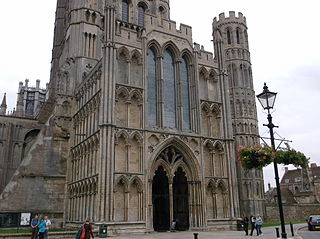Related Research Articles
Thomas Langton was chaplain to King Edward IV, before becoming successively Bishop of St David's, Bishop of Salisbury, Bishop of Winchester, and Archbishop-elect of Canterbury.

Eustace was the twenty-third Lord Chancellor of England, from 1197 to 1198. He was also Dean of Salisbury and Bishop of Ely.
Alexander Neville was a late medieval prelate who served as Archbishop of York from 1374 to 1388.

Lawrence Booth served as bishop of Durham and lord chancellor of England, before being appointed archbishop of York.

The Bishop of Worcester is the head of the Church of England Diocese of Worcester in the Province of Canterbury, England. The title can be traced back to the foundation of the diocese in the year 680. From then until the 16th century, the bishops were in full communion with the Roman Catholic Church. During the Reformation, the church in England broke away from the authority of the Pope and the Roman Catholic Church, at first temporarily and later more permanently. Since the Reformation, the Bishop and Diocese of Worcester has been part of the Church of England and the Anglican Communion.

The Bishop of Hereford is the ordinary of the Church of England Diocese of Hereford in the Province of Canterbury. Until 1534, the Diocese of Hereford was in full communion with the Roman Catholic Church and two of its bishops were canonised. During the English Reformation the bishops of England and Wales conformed to the independent Church of England under Henry VIII and Edward VI, but, under Mary I, they adhered to the Roman Catholic Church. Since the accession of Elizabeth I the diocese has again been part of the Church of England and Anglican Communion.

The Bishop of Rochester is the ordinary of the Church of England's Diocese of Rochester in the Province of Canterbury.

The Bishop of Winchester is the diocesan bishop of the Diocese of Winchester in the Church of England. The bishop's seat (cathedra) is at Winchester Cathedral in Hampshire.

The Bishop of Salisbury is the ordinary of the Church of England's Diocese of Salisbury in the Province of Canterbury. The diocese covers much of the counties of Wiltshire and Dorset. The see is in the City of Salisbury where the bishop's seat is in the Cathedral Church of the Blessed Virgin Mary. The current bishop is Stephen Lake.

Walter Skirlaw was an English bishop and diplomat. He was Bishop of Durham from 1388 to 1406. He was an important adviser to Richard II of England and Henry IV of England.

Richard Mitford was an English cleric and administrator. He was bishop of Chichester from 17 November 1389, consecrated on 10 April 1390, and then bishop of Salisbury. He was translated to the see of Salisbury on 25 October 1395.
Nicholas Bubwith (1355-1424) was a Bishop of London, Bishop of Salisbury and Bishop of Bath and Wells as well as Lord Privy Seal and Lord High Treasurer of England.

John Arundel was a medieval Bishop of Chichester.
Ralph of Maidstone was a medieval Bishop of Hereford.

Richard Beauchamp was a medieval Bishop of Hereford and Bishop of Salisbury.
Thomas Jane was a medieval Bishop of Norwich.
Henry Sandford was a medieval Bishop of Rochester.
Lawrence of St Martin was a medieval Bishop of Rochester.

John Blyth or John Blythe was a medieval Bishop of Salisbury.
Charles Booth, D.C.L. was a sixteenth-century clergyman who served as the Bishop of Hereford from 1516 to 1535.
References
- Bishops of Salisbury [ unreliable source ] accessed on 31 August 2007
- Britain Express: Salisbury Cathedral accessed on 31 August 2007
- Fryde, E. B.; Greenway, D. E.; Porter, S.; Roy, I. (1996). Handbook of British Chronology (Third revised ed.). Cambridge, UK: Cambridge University Press. ISBN 0-521-56350-X.
- Touchet Family accessed on 31 August 2007 (pay to access)[ unreliable source? ]
- Tudor Place: Edmund Touchet [ unreliable source ] accessed on 31 August 2007
